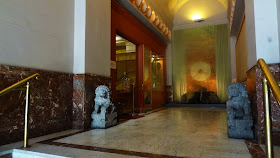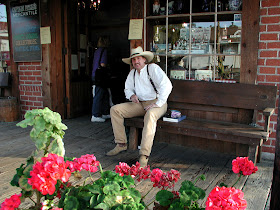Hacıbektaş 46 km from the
city of Nevşehir is notable in that it is the home of a famous
dervish dergâh (lodge) in the centre of the town. Hacıbektaş is the sacred
centre of Alevi Islam, and every year on 16, 17 and 18 August, tens of
thousands of faithful flock here. They come from communities that follow the
teachings of Hacı Bektaş Veli, whose emphasis on peace and tolerance make his a
universally relevant doctrine still widely popular today.
The life of Hacı
Bektaş Veli is shrouded in mystery. All that is known are
stories and legends passed down by word of mouth until they were written down
several centuries after his death in a book entitled the Velayetname by a
Bektaşi dervish. It is believed that Hacı Bektaş was descended from the Caliph
Ali (Alevi means those who follow in the footsteps of Ali), and his date of
birth is given variously as 1209 and 1247. The Velayetname tells us that Hacı
Bektaş came from Nishapur in Turkistan, where he was the student of Lokman
Perende, one of the followers of Ahmed Yesevi.
He later migrated to Anatolia,
where he settled in Sulucakarahöyük and began to spread the teachings of the Alevi
mystic tradition in Turkey. These teachings, which came to be known as Bektaşi,
address the heart, and urge friendship and humility instead of strife. Much
later his teachings were given systematic form by the 15th-16th century Bektaşi
dervish Balım Sultan, and so the Bektaşi dervish order gained its body of
tradition over the centuries.

The dergâh or
dervish lodge of Hacıbektaş became a museum in 1964. The entrance leads into a
large courtyard, to the right of which once stood buildings accommodating the
dervishes who worked the land and farm labourers employed by the lodge. These
buildings were demolished when the lodge was being converted into a museum, and
a wall built here.
At the far end of the wall is the Üçler Fountain symbolising
the Creator, Muhammed and Ali, a fundamental concept of Alevi faith. An open
space on the left is like a small park, and originally there were stables for
the horses of guests, barns and other outbuildings here. At the end of the
courtyard a gate leads into a second courtyard, where there is a pool with a
border of flowers. If it is not too crowded you can drink from the holy water
of the Lion Fountain. The inscription over this fountain explains that the lion
statue was brought from Egypt as a gift to the lodge in 1853.
The second
courtyard was the busiest part of the lodge, with the aşevi (refectory),
pantry, hamam (baths), guest house, hall where the sacred services known as cem
were held, and the pavilion where the lodge’s leader, the Dedebaba, received
guests.
The final gateway leads into the third courtyard where the tomb of Hacı
Bektaş Veli stands. On the right are the graves of dervishes belonging to the
lodge, and in the small mausoleum just beyond lie Balım Sultan and Kalender
Şah, two great figures of the order.
The ancient wishing tree in front of the
mausoleum is one of the places which visitors never fail to stop at. Before
entering the mausoleum it is customary for visitors to embrace the cylindrical
marble stone in the right-hand corner. If you can embrace it with two arms,
then it is regarded as proof that your heart is clean and your intentions pure.
The tomb was built by Şeyhsuvar Ali, lord of the Dulkadirogulları principality,
in 1519 following the death of Balım Sultan.
The walls of the
mausoleum are decorated with painted kalem işi
(ornamental decorative arabesque brushwork), and there are examples of Bektaşi
calligraphy. The door is original. The mausoleum of Hacı Bektaş Veli himself is
known as Pir Evi, and at the entrance are the graves of the baba’s of the
order, dervishes who attained the highest degree.
As you walk towards the
Kırklar Meydanı hall, on the right you pass the çilehane, a cell where the
dervishes spent time alone in the presence of God. If you wish to see inside
you must bend almost double, and a few minutes alone in that dark cell gives
you an impression at least of what it must have been like for the dervishes who
came here. On the raised platform to the left of the Kırklar Meydanı are buried
the descendants of Hacı Bektaş who sat on the ceremonial fleece of office and
were known as çelebi or bel evlatları.

In this hall
where the dervishes performed the ceremonial dance known as the kırklar semahı,
are now exhibited the twelve sided stones known as teslim taşı which the
dervishes hung around their necks as symbols of the Bektaşi order, earrings
worn by unmarried dervishes who devoted their lives to serving their lodge,
handwriting of the Caliph Ali on gazelle skin, beautiful examples of calligraphy,
torches, censers, and the Kırkbudak Candelabra which according to the
Velayetname came from India. Finally a small door on the right leads into the
tomb chamber of Hacı Bektaş Veli, where visitors walk three times around the
sarcophagus before offering up a supplication to Hacı Bektaş Veli.
In the 14th to 15th centuries, lived Balim Sultan who was the great master who enriched systemic Bektaşism. He was born to a Balkan Greek mother. Balim Sultan’s tomb/shrine lies in the compounds of Haci Bektaş. Visitors that pay their respects to Haci Bektaş Veli also visit Balim Sultan’s shrine.
Near the lodge is Dedebagı, an open park scattered with trees, where visitors
who have come for the commemoration ceremonies gather to picnic and drink the
ice-cold spring water from a fountain known as Şekerpınar. A lay moslem cemetery is also found adjacent to these grounds.
The teachings of
this sect of Islam seem particularly humane and enlightened and are summarised
by the key teachings of Hacı Bektaş Veli:
“Search and
find.
Educate the
women.
Even if you are
hurt, do not hurt others.
Sages are pure
and sometimes purifiers.
The first stage
of attainment is modesty.
Whatever you
look for, search for it firstly within you.
Do not forget
that even your enemy is human.
Control your
hand, your words, your lust.
The beauty of
human beings is in the beauty of their words.
Prophets and
saints are God’s gifts to humanity.
The road that
does not pass through science is perilous.
Do not try to
find faults in either nations or individuals.
Blessed are
those who try to enlighten the darkness of thought.
Do not do unto
others what you do not wish to be done unto you.
Peace be with
you!”























































